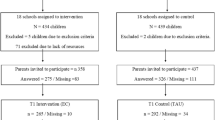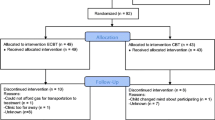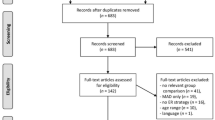Abstract
Cognitive behavioural therapy (CBT) for childhood anxiety has shown moderate effects. However, inconsistency in findings during the last decades of treatment research and lack of measurable treatment gains over time has led to a call for optimizing interventions by identifying the active mechanisms involved and for whom such interventions are effective. It has been suggested that the moderate effects may be explained by the fact that emotion regulation rarely is directly targeted in CBT-interventions and that interventions may be more effective for children with a certain level of problems with emotion regulation. Using data from a randomized controlled trial with 160 children and their mothers at baseline (t1) and posttreatment (t2), we examined whether being randomized to CBT predicted change in anxiety symptoms from t1 to t2 and whether this change was mediated by change in emotion regulation from t1 to t2. We also investigated whether the strength of this indirect pathway depended on the level of emotion regulation problems at baseline. Latent baseline target moderated mediation analyses within a structural equation modelling framework were conducted. Results showed a significant indirect pathway between receiving CBT to improved emotion regulation, which again was significantly associated with reductions in anxiety symptoms. The findings suggest that the effect of CBT is similar for children irrespective of initial levels of emotion regulation measured broadly, whereas there was some evidence of a baseline moderation effect of the subdomain emotional control. Emotion regulation, and especially emotional control, seems to be an underlying mechanism for positive effects of CBT for anxiety disorders in children, possibly indicating that a greater emphasis on emotion regulation may optimize the intervention.



Similar content being viewed by others
References
Afshari, A., Neshat-Doost, H. T., Maracy, M. R., Ahmady, M. K., & Amiri, S. (2014). The effective comparison between emotion-focused cognitive behavioral group therapy and cognitive behavioral group therapy in children with separation anxiety disorder. Journal of Research in Medical Sciences: THe Official Journal of Isfahan University of Medical Sciences, 19, 221.
Aldao, A., Gee, D. G., De Los Reyes, A., & Seager, I. (2016). Emotion regulation as a transdiagnostic factor in the development of internalizing and externalizing psychopathology: Current and future directions. Development and Psychopathology, 28, 927–946.
Aldao, A., Jazaieri, H., Goldin, P. R., & Gross, J. J. (2014). Adaptive and maladaptive emotion regulation strategies: Interactive effects during CBT for social anxiety disorder. Journal of Anxiety Disorders, 28, 382–389.
Bjaastad, J. F., Haugland, B. S. M., Fjermestad, K. W., Torsheim, T., Havik, O. E., Heiervang, E. R., & Öst, L. G. (2016). Competence and Adherence Scale for Cognitive Behavioral Therapy (CAS-CBT) for anxiety disorders in youth: Psychometric properties. Psychological Assessment, 28(8), 908.
Brown, C. H., Sloboda, Z., Faggiano, F., Teasdale, B., Keller, F., Burkhart, G., & Wang, W. (2013). Methods for synthesizing findings on moderation effects across multiple randomized trials. Prevention Science, 14, 144–156.
Caspi, A., & Moffitt, T. E. (2018). All for one and one for all: Mental disorders in one dimension. American Journal of Psychiatry, 175, 831–844.
Caspi, A., Houts, R. M., Belsky, D. W., Goldman-Mellor, S. J., Harrington, H., Israel, S., & Poulton, R. (2014). The p factor: One general psychopathology factor in the structure of psychiatric disorders? Clinical Psychological Science, 2, 119–137.
Collins, L. M., Kugler, K. C., & Gwadz, M. V. (2016). Optimization of multicomponent behavioral and biobehavioral interventions for the prevention and treatment of HIV/AIDS. AIDS and Behavior, 20, 197–214.
Curran, P. J., & Hussong, A. M. (2009). Integrative data analysis: the simultaneous analysis of multiple data sets. Psychological Methods, 14, 81.
Ferrer, E., Balluerka, N., & Widaman, K. F. (2008). Factorial invariance and the specification of second-order latent growth models. Methodology, 4, 22–36.
Geiser, C., Eid, M., Nussbeck, F. W., Courvoisier, D. S., & Cole, D. A. (2010). Analyzing true change in longitudinal multitrait-multimethod studies: Application of a multimethod change model to depression and anxiety in children. Developmental Psychology, 46, 29.
Gioia, G. A., Isquith, P. K., Guy, S. C., & Kenworthy, L. (2000). Behavior rating inventory of executive function: BRIEF: Psychological Assessment Resources Odessa, FL.
Graham, J. W. (2009). Missing data analysis: Making it work in the real world. Annual Review of Psychology, 60, 549–576.
Gratz, K. L., & Roemer, L. (2004). Multidimensional assessment of emotion regulation and dysregulation: Development, factor structure, and initial validation of the difficulties in emotion regulation scale. Journal of Psychopathology and Behavioral Assessment, 26(1), 41–54.
Gratz, K. L., Weiss, N. H., & Tull, M. T. (2015). Examining emotion regulation as an outcome, mechanism, or target of psychological treatments. CurrentOopinion in Psychology, 3, 85–90.
Hannesdottir, D. K., & Ollendick, T. H. (2007). The role of emotion regulation in the treatment of child anxiety disorders. Clinical Child and Family Psychology Review, 10, 275–293.
Hayes, A. F. (2009). Beyond Baron and Kenny: Statistical mediation analysis in the new millennium. Communication Monographs, 76, 408–420.
Hayes, A. F. (2015). An index and test of linear moderated mediation. Multivariate Behavioral Research, 50, 1–22.
Hayes, A. F., & Preacher, K. J. (2013). Conditional process modeling: Using structural equation modeling to examine contingent causal processes.
Howe, G. W. (2019). Using baseline target moderation to guide decisions on adapting prevention programs. Development and Psychopathology, 31, 1777–1788.
Howe, G. W., Beach, S. R., Brody, G. H., & Wyman, P. A. (2016). Translating genetic research into preventive intervention: the baseline target moderated mediator design. Frontiers in Psychology, 6, 1911.
Hu, L. T., & Bentler, P. M. (1999). Cutoff criteria for fit indexes in covariance structure analysis: Conventional criteria versus new alternatives. Structural Equation Modeling: A Multidisciplinary Journal, 6, 1–55.
Hugh-Jones, S., Beckett, S., Tumelty, E., & Mallikarjun, P. (2020). Indicated prevention interventions for anxiety in children and adolescents: a review and meta-analysis of school-based programs. European Child & Adolescent Psychiatry, 1–12.
Kazdin, A. E. (2011). Evidence-based treatment research: Advances, limitations, and next steps. American Psychologist, 66, 685.
Kendall, P. C., Martinsen, K., & Neumer, S. (2006). Mestringskatten (Coping Cat). Kognitiv atferdsterapi for barn med angst. Terapeutmanual. Oslo: Universitetsforlaget.
Kendall, P. C., & Peterman, J. S. (2015). CBT for adolescents with anxiety: Mature yet still developing. American Journal of Psychiatry, 172, 519–530.
Kessler, R. C., Petukhova, M., Sampson, N. A., Zaslavsky, A. M., & Wittchen, H. U. (2012). Twelve-month and lifetime prevalence and lifetime morbid risk of anxiety and mood disorders in the United States. International Journal of Methods in Psychiatric Research, 21, 169–184.
Klein, A., & Moosbrugger, H. (2000). Maximum likelihood estimation of latent interaction effects with the LMS method. Psychometrika, 65, 457–474.
Kroes, M., Kalff, A. C., Kessels, A. G., Steyaert, J., Feron, F. J., Van Someren, A. J., & Rozendaal, N. (2001). Child psychiatric diagnoses in a population of Dutch schoolchildren aged 6 to 8 years. Journal of the American Academy of Child & Adolescent Psychiatry, 40, 1401–1409.
Leijten, P., Dishion, T. J., Thomaes, S., Raaijmakers, M. A., Orobio de Castro, B., & Matthys, W. (2015). Bringing parenting interventions back to the future: How randomized microtrials may benefit parenting intervention efficacy. Clinical Psychology: Science and Practice, 22, 47–57.
Leijten, P., Raaijmakers, M., Wijngaards, L., Matthys, W., Menting, A., Hemink-van Putten, M., & de Castro, B. O. (2018). Understanding who benefits from parenting interventions for children’s conduct problems: an integrative data analysis. Prevention Science, 19, 579–588.
Lenz, A. S., & Hollenbaugh, K. M. (2015). Meta-analysis of trauma-focused cognitive behavioral therapy for treating PTSD and co-occurring depression among children and adolescents. Counseling Outcome Research and Evaluation, 6, 18–32.
Lodder, P., Denollet, J., Emons, W. H., Nefs, G., Pouwer, F., Speight, J., & Wicherts, J. M. (2019). Modeling interactions between latent variables in research on Type D personality: a Monte Carlo simulation and clinical study of depression and anxiety. Multivariate Behavioral Research, 54, 637–665.
March, J. S., Parker, J. D., Sullivan, K., Stallings, P., & Conners, C. K. (1997). The Multidimensional Anxiety Scale for Children (MASC): factor structure, reliability, and validity. Journal of the American Academy of Child & Adolescent Psychiatry, 36(4), 554–565.
McArdle, J. J. (2009). Latent variable modeling of differences and changes with longitudinal data. Annual Review of Psychology, 60, 577–605.
Merikangas, K. R., He, J. -P., Brody, D., Fisher, P. W., Bourdon, K., & Koretz, D. S. (2010). Prevalence and treatment of mental disorders among US children in the 2001–2004 NHANES. Pediatrics, 125, 75–81.
Moltrecht, B., Deighton, J., Patalay, P., & Edbrooke-Childs, J. (2020). Effectiveness of current psychological interventions to improve emotion regulation in youth: a meta-analysis. European Child & Adolescent Psychiatry, 1–20.
Muthén, L., & Muthén, B. (2012). Mplus User’s Guide Seventh Edition Los Angeles. CA: Muthén and Muthén.
Öst, L. -G. (2010). KBT inom barn- och ungdomspsykiatrin. Stockholm: Natur & Kultur.
Öst, L. -G., & Ollendick, T. H. (2017). Brief, intensive and concentrated cognitive behavioral treatments for anxiety disorders in children: a systematic review and meta-analysis. Behaviour Research and Therapy, 97, 134–145.
Paulus, F. W., Backes, A., Sander, C. S., Weber, M., & von Gontard, A. (2015). Anxiety disorders and behavioral inhibition in preschool children: a population-based study. Child Psychiatry & Human Development, 46, 150–157.
Preacher, K. J., Rucker, D. D., & Hayes, A. F. (2007). Addressing moderated mediation hypotheses: Theory, methods, and prescriptions. Multivariate Behavioral Research, 42(1), 185–227.
Schafer, J. L., & Graham, J. W. (2002). Missing data: Our view of the state of the art. Psychological Methods, 7, 147.
Schäfer, J. Ö., Naumann, E., Holmes, E. A., Tuschen-Caffier, B., & Samson, A. C. (2017). Emotion regulation strategies in depressive and anxiety symptoms in youth: a meta-analytic review. Journal of Youth and Adolescence, 46, 261–276.
Sloan, E., Hall, K., Moulding, R., Bryce, S., Mildred, H., & Staiger, P. K. (2017). Emotion regulation as a transdiagnostic treatment construct across anxiety, depression, substance, eating and borderline personality disorders: a systematic review. Clinical Psychology Review, 57, 141–163.
Sørensen, L., & Hysing, M. (2014). Måleegenskaper ved den norske versjonen av Behavior Rating Inventory Executive Function (BRIEF).
Suveg, C., Jones, A., Davis, M., Jacob, M. L., Morelen, D., Thomassin, K., & Whitehead, M. (2018). Emotion-focused cognitive-behavioral therapy for youth with anxiety disorders: a randomized trial. Journal of Abnormal Child Psychology, 46, 569–580.
Suveg, C., Sood, E., Comer, J. S., & Kendall, P. C. (2009). Changes in emotion regulation following cognitive-behavioral therapy for anxious youth. Journal of Clinical Child & Adolescent Psychology, 38, 390–401.
Vallis, E. H., Zwicker, A., Uher, R., & Pavlova, B. (2020). Cognitive-behavioural interventions for prevention and treatment of anxiety in young children: a systematic review and meta-analysis. Clinical Psychology Review, 101904.
Villabø, M., Gere, M., Torgersen, S., March, J. S., & Kendall, P. C. (2012). Diagnostic efficiency of the child and parent versions of the Multidimensional Anxiety Scale for Children. Journal of Clinical Child & Adolescent Psychology, 41, 75–85.
Villabø, M. A., Narayanan, M., Compton, S. N., Kendall, P. C., & Neumer, S. -P. (2018). Cognitive–behavioral therapy for youth anxiety: an effectiveness evaluation in community practice. Journal of Consulting and Clinical Psychology, 86, 751.
Weisz, J. R., Kuppens, S., Ng, M. Y., Vaughn-Coaxum, R. A., Ugueto, A. M., Eckshtain, D., & Corteselli, K. A. (2019). Are psychotherapies for young people growing stronger? Tracking trends over time for youth anxiety, depression, attention-deficit/hyperactivity disorder, and conduct problems. Perspectives on Psychological Science, 14, 216–237.
Widaman, K. F., Ferrer, E., & Conger, R. D. (2010). Factorial invariance within longitudinal structural equation models: Measuring the same construct across time. Child DevelopmentPerspectives, 4, 10–18.
Funding
186036/V50 Grant Funding Number Norwegian Research Council to conduct the main study. Primary sponsor: The Centre for Child and Adolescent Mental Health – Eastern and Southern Norway (RBUP East and South), Gullhaugveien 1–3, 0484 Oslo, mail@r-bup.no.
Author information
Authors and Affiliations
Corresponding author
Ethics declarations
Ethics Approval
Ethics approval for the study was given by the Regional Committees for Medical and Health Research Ethics (REK; https://helseforskning.etikkom.no), reference number 2010/3187/REK sør-øst C. The study was performed in accordance with the ethical standards as laid down in the 1964 Declaration of Helsinki and its later amendments or comparable ethical standards.
Consent to Participate
The study was conducted in accordance with prevailing ethical standards in the field and approval from the Norwegian Data Inspectorate. Informed consent was obtained from all participants.
Conflict of Interest
S.-P. Neumer receives royalties from the sale of the Coping Cat manual.
Additional information
Publisher's Note
Springer Nature remains neutral with regard to jurisdictional claims in published maps and institutional affiliations.
Supplementary Information
Below is the link to the electronic supplementary material.
Rights and permissions
About this article
Cite this article
Helland, S.S., Baardstu, S., Kjøbli, J. et al. Exploring the Mechanisms in Cognitive Behavioural Therapy for Anxious Children: Does Change in Emotion Regulation Explain Treatment Effect?. Prev Sci 24, 214–225 (2023). https://doi.org/10.1007/s11121-022-01341-z
Accepted:
Published:
Issue Date:
DOI: https://doi.org/10.1007/s11121-022-01341-z




